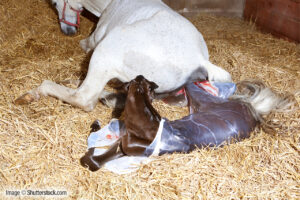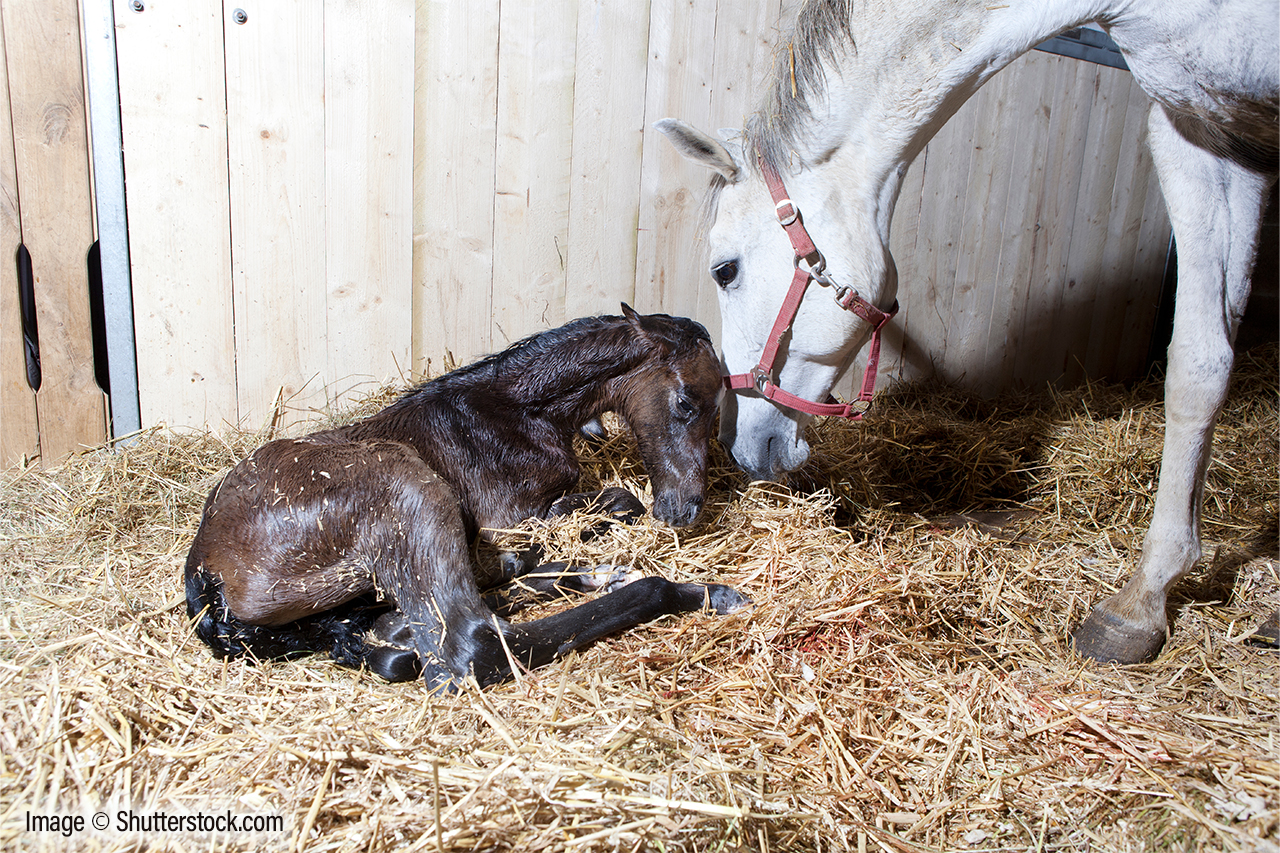1. Tetanus vaccine for mare 1 month before foaling and if not recently done. Normal Flu vaccination protocol.
2. Mare should have had herpes vaccination at 5, 7, and 9 months of pregnancy.
3. Ivermectin wormer for mare on day of foaling to reduce Strongyloides westeri infestation to foal
4. Episiotomy if necessary (if mare has been stitched) 1 week before foal due date if not being observed 24hours/day or otherwise at foaling
5. Record date when udder starts to enlarge dramatically (starts 4 weeks prior to foaling & very large at 2 weeks pre foaling as a rough guide)
6. Record date of waxing up (average 1-4 days pre-foaling, but some mares don’t & it can be a few weeks before)
7. As foaling approaches udder secretions change from thin straw-coloured fluid to milky white fluid & eventually thick sticky yellow/orange colostrum
8. Best time to check colostrum quality on refractometer is as waters break, then if poor quality a supply if available can be defrosted
9. Bandage mares tail & clean perineum (warm clean water) & dry (paper towel) when first stage labour begins
10. First stage labour (mare restless / sweats) lasts on average 30 mins – 4 hours
11. ‘Waters break’ – a lot of fluid & second stage labour begins (RED BAG AT THIS STAGE IS AN EMERGENCY – NEEDS TO BE BROKEN & FOALING ASSISTED – FOALS OXYGEN SUPPLY DEPLETING RAPIDLY)
12. Shiny white bag (amnion) appears closely followed by a front foot, then second foot (soles point downwards)
13. Nose appears on fetlock/cannons
14. Mare often gets up & repositions before head etc follow
15. As the head emerges the amnion (white shiny bag) usually ruptures (if not, it may be broken manually)
16. If foal needs to be pulled, check you have front feet and foal in correct position, pull in time with mare contractions and in an arc (CALL VET)
17. Once foal hips are out, mare often rests
18. As long as foal is breathing & nose is clear of amnion & fluid leave well alone (IF FOAL IS NOT BREATHING, CHECK NOSTRILS ARE CLEAR & RUB CHEST BRISKLY WITH A TOWEL; A PIECE OF STRAW POKED INTO A NOSTRIL MAY STIMULATE A RESPONSE. USE FOAL RESUSCITATOR)
19. After about 20mins mare may rise & cord breaks
20. Natural place for the cord to break is 2-5cm away from the foals belly
21. There is usually no need to break the cord
22. Once a small amount of haemorrhage has occurred the cord stump can be sprayed with Vetasept Chlorhexidine Clear spray (repeat 8 hourly for 4 applications) or dipped in dilute Iodine.
23. Second stage of labour usually takes 20-30 minutes
24. Stage three of labour is expulsion of fetal membranes & uterine involution
25. Fetal membranes usually come away after 30mins-3 hours (IF NOT LOST AFTER 6 HOURS, VETERINARY ATTENTION SHOULD BE SOUGHT – SOONER IN HEAVIER HORSES!!)
26. The membranes should be inspected & kept for veterinary examination
27. Normal foal usually breathes within 1 min
28. Normal foal usually has lifted head & attempted sternal recumbancy within 5 min
29. Normal foal usually has a suck reflex within 5 min
30. Normal foal usually attempts to stand within 30 min
31. Normal foal usually able to stand unassisted within 60 –120 min
32. Normal foal usually nurses from udder within 60 – 180 min
33. The above are general guidelines, but certainly if a foal which has had no colostrum by 3 hours of age start to milk mare (500mls would be great!) & call the vet to stomach tube foal
34. If foal appears weak or there is concern over quality of colostrum, an IgG test can be performed on the foal. An IgG test is best performed when foal is checked over at 8-18 hours of age; if levels are >800mg/dl fine; if 4-800mg/dl consider plasma transfer & consider further blood tests; if<400mg/dl then plasma transfer essential
35. For insurance purposes you may need exact IgG levels from Beaufort labs
36. Blood testing foal at 24 hours old for haematology & biochemistry is routine on thoroughbred studs

Foal & mare vet check at 8-18 hours post foaling (sooner if complications) to include physical examination of mare & foal; prophylactic 3 day antibiotics only given if foal compromised or poor hygiene; foal tetanus anti-toxoid is still advisable even, if mare recently vaccinated; phosphate enema if no meconium passed 0.5-1litre water & lubrel OK. Blood tests if foal poorly.
37. Several times per day the mares udder should be observed, the foals behaviour noted & its navel monitored. Normal urination & faeces should be seen. Navel sprayed with Vetasept or Alamycin 8 hourly for 4 applications.
38. (Thoroughbred) foal checked again at 3-4 weeks of age & 2nd tetanus anti toxoid given (time for identification, micro-chip & bloods)
39. Foals begin worming program at 4 weeks with Panacur or Ivermectin
40. Vaccinations for Influenza, Tetanus & Herpes begin from 5 months of age
41. Weight recorded ?monthly?
42. Use record charts
Rectal temperature – foal – Normal 99.5° -100.5°F (37.5 – 38.5°C)
Below 98.5°F or above 101.5°F cause for concern
Reviewed May 2019
